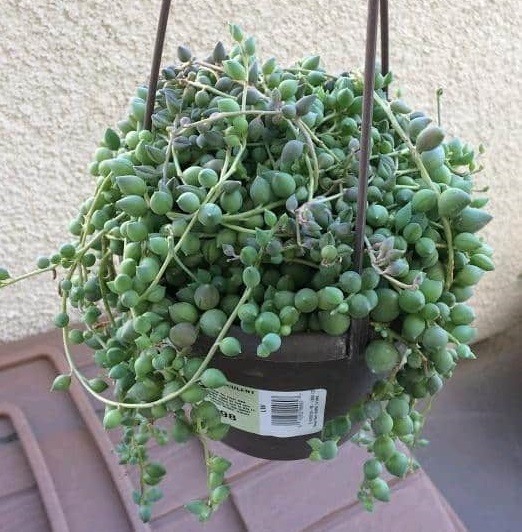A healthy string of pearls has plump green leaves that create a lasting impression in any interior space. But the string of pearls plant is intimidating to grow and maintain at home. The succulent plant is more vulnerable to leaves turning black, purple, and brown problems.
So, why is my string of pearls turning black? Black leaves on the string of pearls are due to incorrect lighting, inappropriate watering, low humidity, bacterial infection, and physical stress. Identification of the exact cause will help to take appropriate action.
The information in this article will help identify the possible causes with their respective solutions to save your string of pearls plant. Take the time to read through it and treat the black leaves on your succulent plant.
You May Also Like: 25 Stunning Peperomia Varieties with Pictures

Reasons for String of Pearls Turning Black
Incorrect Lighting Conditions
The string of pearls thrives under bright indirect sunlight. Black leaves on your plant are due to low and excess light. Direct sunlight will scorch the leaves and turn black.
The string of pearls cannot tolerate direct sunlight. The heat from the sun tends to stress the plant and make the leaves turn brown or black.
The succulent plant can handle low lighting conditions for a short period. But low lighting tends to inhibit photosynthesis and invite more problems.
Leggy stems and black leaves are signs of incorrect lighting conditions. Relocate the succulent plant to an area that receives bright indirect sunlight or artificial grow lights.
Inappropriate Watering Regime
Black leaves on the string of pearls are due to improper watering routine. Both under-watering and overwatering can harm your succulent plant.
An overwatered string of pearls develops root rot and black leaves. The fungal growth inhibits the roots from absorbing water and nutrients.
Nutritional deficiency issue is the reason behind the string of pearls turning black, brown, and yellow. The succulent plant will die if not treated at the right time.
Under-watering makes the string of pearls dehydrate and dull. It will become droopy and dry in the long run. Leaves turning brown and black are other signs of under-watering.
Treating an under-watered string of pearls is easier than the overwatered counterpart. Always inspect the soil moisture content before watering your string of pearls.
Sudden Temperature Changes
A string of pearls plant does best under room temperature. A sudden rise or fall in temperature will shock your succulent plant and cause black leaves.
The shock will make the string of pearl leaves shrivel and turn black or brown. Do not exposure your succulent plant to hot and cold drafts.
Relocate the plant to a location with constant room temperature. The stress-free area will help combat the black leaves on your string of pearls.
Inappropriate Fertilization
A string of pearls is a light feeder succulent plant. It does not need fertilizer nutrients to thrive well in its native habitat. But a potted string of pearls needs little fertilizer application.
Too much or too little fertilizer can cause problems with your succulent plant. Excess fertilizer application will burn the roots and make tips of the leaves black or brown.
Inadequate fertilizer application will foster stunted growth. A string of pearls turning black is also a sign of nutritional deficiency.
Feed your succulent plant every month during spring and summer. Do not apply fertilizer to your string of pearls during winter due to the dormancy effect.
Pest Infestation
A string of pearls plant is vulnerable to spider mites, aphids, and whiteflies. These sap-sucking creatures will make the leaves of your plant black.
Pests suck sap from the succulent plant to result in nutritional deficiency. These tiny insects can also damage the root systems and cause leaves discoloration.
Use an insecticidal soap spray to eliminate these pests. Remember to isolate the plant from your houseplant collection to prevent pests from spreading.
Bacterial and Fungal Diseases
Both fungal and bacterial infections on the string of pearls are due to inappropriate caring routines. The overwatering, low light conditions and poor ventilation problems cause plant diseases.
The bacterial infection causes the string of pearls to develop yellow spots on the leaves’ undersides. The leaves will later turn black if not treated.
Black spots on the leaves of the string of pearls are due to fungal infection. Isolate the plant from your houseplant collections to prevent the fungal disease from spreading.
Use copper fungicides to treat fungal infection and provide the ultimate string of pearls care. The routine will help to prevent bacterial and fungal diseases in the future.
You May Also Enjoy: How to Care for Hoya Carnosa Compacta (Hindu Rope Plant)
Related Questions
How often Should I Water String of Pearls?
Once every week. Remember the string of pearls will utilize more water during spring and summer than winter. Inspect the soil moisture before watering your succulent plant.
How Much Sunlight Does a String of Pearls Need?
Six to eight hours a day. The string of pearls thrives under bright indirect sunlight. Direct sunlight exposure will scorch the leaves.
Why Are My String of Pearls Shriveling?
Under-watering is the main reason behind the little round leaves shriveling. The issue is due to a dehydrated string of pearls. Soak the potting soil with distilled water to revive the plant.
You May Also Read: 15 Best Calathea Varieties with Names and Pictures
Final Thoughts
A string of pearls turns black due to under-watering, overwatering, direct sunlight exposure, and sudden indoor temperature changes. Identify the cause and fix it immediately.
I hope the information in this article will make your work easier. Feel free to share the information with other houseplant enthusiasts in your circle.
